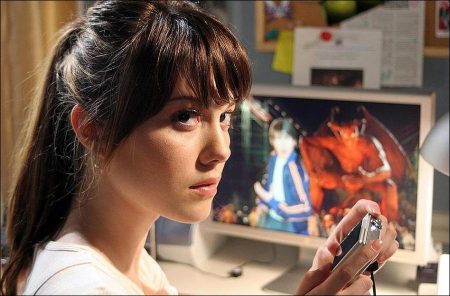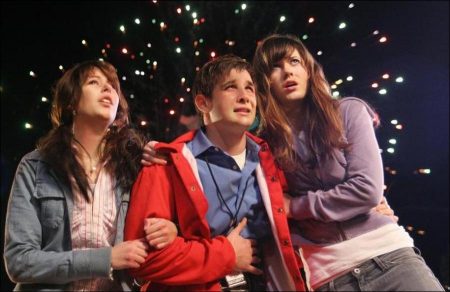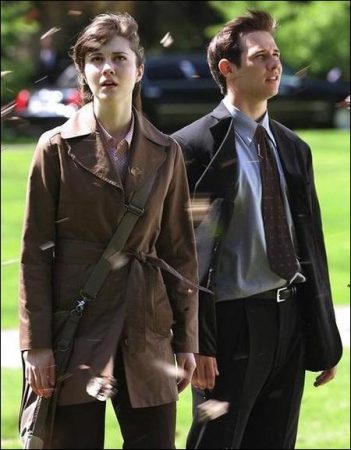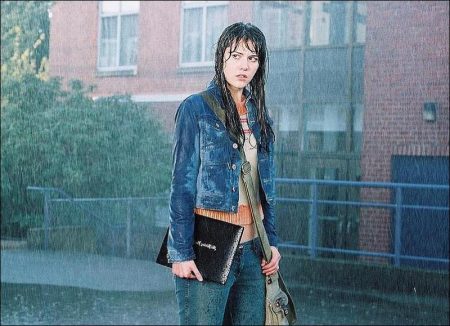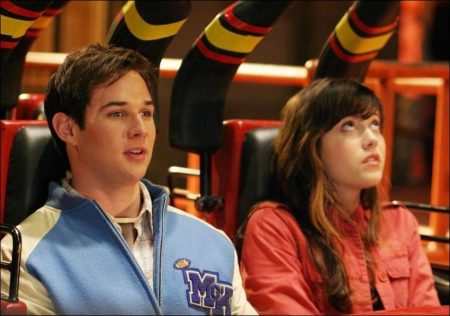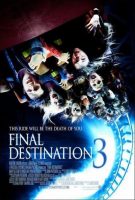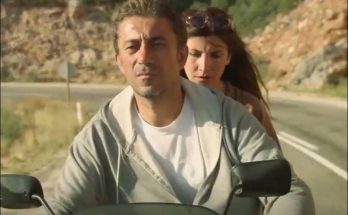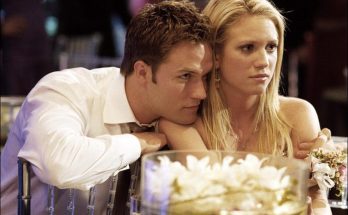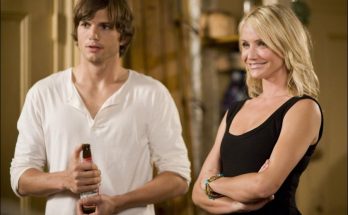On what should be one of the happiest days of her life, high school senior Wendy (Mary Elizabeth Winstead) joins her friends for a graduation night celebration at a local amusement park. As they’re about to board a roller coaster, Wendy is suddenly spooked. Her boyfriend Jason (Jesse Moss) reassures her that it’s merely the act of relinquishing control that’s giving her the jitters. Wendy overcomes her fear, but no sooner has the pneumatic harness descended, securing her in her seat, than Wendy experiences a vivid premonition of a fatal accident in which the roller coaster becomes a death trap for her and her friends.
Emerging from her terrifying vision and still on the ride platform, Wendy freaks out and demands to be let off. Her classmate, Kevin (Ryan Merriman), who’s seated beside her, feels compelled to accompany Wendy. As they’re leaving, Lewis (Texas Battle) taunts Kevin, calling him a wimp. Insults turn to blows, others join the scuffle, and soon a handful of students are forcibly ejected from the ride. As they watch from below, Wendy’s premonition proves nightmarishly true – the coaster careens out of control, and all those aboard perish. But that’s only the beginning…
Those who survive the disaster discover that fate is hard to escape. They were meant to die… and death is not so easily cheated! It’s not long before death comes to claim its next victim, and it’s through this tragedy that Wendy realizes there are clues to the survivors’ impending demise contained in photos she took at the amusement park that fateful night. As Wendy and Kevin desperately try to interpret the clues that might save lives, one-by-one their friends meet fantastically gruesome ends… and soon it will be their turn.
About the Production
When your number’s up, it’s up!
“I think the idea of fate has always been in people’s heads. Are we fated to meet the one we marry? How will we die? These are questions that everyone’s thought about,” says director James Wong, who with producer Glen Morgan, wrote the screenplay for Final Destination 3, as well as the original Final Destination which was released in 2000 (Final Destination 2 was released in 2002).
Producer Craig Perry, who has shepherded all three films in the franchise, believes that it is this human curiosity about life and death that gives the films their broad appeal. “I think the whole franchise taps into the common fears we all have about dying,” he says. “It addresses questions like, ‘What if I die today? How is it going to happen? Can I stop it? Have I done something that might actually be facilitating my death?’”
The audience comes to observe the inner workings of life and death from a safe distance – and then is challenged to leave these weighty issues behind in the theatre.
“We did a preview for Final Destination 2, which has a terrible elevator sequence in which a woman’s head gets corkscrewed off,” Perry explains. “A bunch of kids were actually waiting for the elevator to go down to the parking lot after the movie. The elevator doors opened, closed, and then half-opened again. The kids all looked at each other, said ‘Screw that,’ and headed for the stairs! For me that as a great moment. It meant that the movie had worked because those kids were scared to death of a real elevator!”
Matching, or ideally exceeding, the nailbiting thrills of the opening sequences of the first two films was the first hurdle filmmakers faced. New Line production executive Richard Brener came up with the idea of staging the opening disaster aboard a roller coaster. Over the course of several cold spring nights in Vancouver, this valiant group of young actors rode the coaster from sun-down to sun-rise, 20-25 times each night.
“I’m a thrill junkie,” says 22-year-old Ryan Merriman, who plays Kevin. “I love roller coasters, so after 17 times it was still cool. It got challenging – you get a little woozy and it’s kind of like having a hangover.”
Mary Elizabeth Winstead adds, “The roller coaster at first was just so much fun because it was something that I haven’t really done since I was a kid. It was an adrenaline rush and it really wasn’t too bad until probably the 13th time around when I started getting a really strange feeling in my head. But I was proud of myself. I didn’t throw up. None of us did.”.
The roller coaster sequence that opens the film is the most complex of all the Final Destination opening sequence disasters. In order to achieve the desired effect, the filmmakers shot coverage of the cast riding the actual roller coaster; soundstage coverage using a replica coaster housed in an enormous set with tracks extending 30 feet up to the ceiling; green-screen elements of the cast doing their own stunt work; and finally, visual effects shots to augment reality and go where no human body can.
Finding a roller coaster to match the one that James Wong and Glen Morgan envisioned in their script proved impossible. “If you’re going to crash a roller coaster, the best possible scenario is to crash the roller coaster,” says visual effects supervisor Ariel Shaw. “Since that wasn’t an option, we extrapolated elements to build our digital model from the roller coaster in Vancouver where we planned to shoot, as well as another roller coaster in California. We combined these two coasters and then added other pieces.
So now we have this ‘Frankencoaster’ that’s pretty cool, but it still doesn’t satiate all of the beats that are in Jim and Glen’s script. The script describes a 250 ft. climb and then a corkscrew drop – then another climb almost as high as the first one, so we made further modifications until we got it right. Then we actually composited it into the environment of the fairgrounds, which required a full scan of the fairgrounds that we could then manipulate in CG,” Shaw explains.
From this point on, Shaw worked closely with director of photography Rob McLachlan, the art department, special effects, stunts, and various other departments to explore the complexities of each specific element in the sequence. “We did a pre-visualization of the sequence that allowed us to work out the mechanics of each scene and see how we were going to shoot it,” he continues. “Would we need to be on a crane? What kind of lens would we use?”
“One of the first things we had to figure out was where and how we would mount the cameras on the coaster,” McLachlan explains. “The clearance on the cars is actually pretty narrow when it’s running through the superstructure of the rollercoaster. We tested it by using large pieces of high density foam mounted in various positions. We ran the coaster and watched as chunks of foam were snapped off. We did this until pieces stopped breaking off, and then we knew how far our cameras could stick out in various positions on the coaster.”
McLachlan also faced the challenge of coming up with a wide variety of shots that would map the trajectory of the coaster while building tension in the scene.
“One of the things that keeps an action sequence going is a progression of shots, so that you never revisit the same shot twice…so that you’re always moving on to something new and different. We used remote control camera systems in a way that I don’t think they’ve been used before, and is quite impressive. We shot with two or three cameras most of the time and used some old movie tricks like having a mirror reflect an object so that it looks like it’s going to run right over the camera.”
To seamlessly create the illusion of all hell breaking loose on the coaster, ingenuity on the part of all was required. “I think the best way to sustain the illusion with stunt work is to come from a different angle for each gag,” says stunt coordinator JJ Makaro. “Where you pull a person for one gag, you drop them for another, and spin them for yet another.”
From the pre-visualization, filmmakers determined which scenes would be shot on the real coaster; which would take place in the replica coaster against green screen; and which would be CGI. The replica coaster also came with a very specific list of performance capabilities. “The challenge of this one was that we effectively had to create six separate gimbals for each of the cars,” says special effects coordinator Rory Cutler. “The important thing was to try and create a synchronous movement between the six cars in the roller coaster chain and do it in a way that would be convincing.”
Most gimbals are fairly straightforward in that they have to position a boat or an airplane, which is usually three dimensions of movement. “Our system had to be able to move in the same three dimensions but on each car, and in proper symmetry to one another,” Cutler continues. “What we ended up with was essentially two very large steel structural towers that suspended the six coaster cars as a chain between them, with each joint of the cars being a hydraulically driven set of couplers that would allow us to generate the angles between the cars.” The six-car coaster rig was 50 feet long, necessitating a green screen that covered the walls, floor and ceiling of nearly an entire sound stage.
There are several shots in which the characters who have survived the first part of the crash are flipped completely upside down. “To do that our gimble, in addition to having joints between the cars, had one massive rotating system that allowed us to take the whole chain of cars and rotate them over 180 degrees,” Cutler explains.
“We wanted to use as much live-action and work with our key talent as much as possible in order to capture the visceral reactions that help build the tension,” says Ariel Shaw. “We needed to make sure that the effects of gravity were true to life.”
It made for an interesting experience for the actors. “We were hanging upsidedown 20 feet off the ground,” Mary Elizabeth Winstead recounts. “We’re screaming and crying because we’re about to fall to our deaths and we’re trying to hold ourselves in the car. The stunt coordinator let the harnesses go just enough so that it would look like we were really holding our own weight, and so just being in the moment I was really freaked out. I was fighting to hold on with my legs and my knees.”
Winstead and Ryan Merriman did virtually all of their own stunt work. “Ryan has a natural flair for movement, and he’s a good athlete,” says stunt coordinator JJ Makaro. “In one scene, we had him take a fall and then blew a fireball at him as he was getting up. We played that one really close, and Ryan was totally up for it.”
The film has its fair share of thrills, chills and gore – but it’s not all blood, guts and dismemberment. “When we had our script read-through with the actors, I was surprised at how legitimately funny the script was,” says producer Craig Perry. “The characters are well-drawn and the situations have that distinctly Morgan and Wong dark, twisted humor.”
Final Destination 3 also brings a new element to the mix that has made the franchise so popular. “We wanted to make FD3 familiar, but different, something new for the audience,” James Wong says. “There has always been a discussion about, ‘If there’s death, is there a sort of opposing life force? If there’s evil is there good?’ ‘And how does that element assert itself?’ We came up with the idea of digital technology, in the form of digital photography. There are digital cameras everywhere – phones are now cameras! It’s not a chemical process, it’s electrical – so we decided to plant clues to how the characters will die in the photographs that Wendy takes the night of the coaster crash. You may take it as death sadistically playing with the characters, showing them how they will die, or you can interpret it as a benevolent life force helping the characters thwart fate and escape death.”
The digital photos also give the audience the opportunity to interpret clues along with the protagonists and attempt to ascertain whose death might be next. “As we go into a new sequence, the audience is armed with a bunch of clues so they can really engage in the movie in a way that they couldn’t with the first two,” comments Craig Perry.
Wendy and Kevin come together in an attempt to save lives – theirs, and those of the other coaster crash survivors – but they are an unlikely couple. “At the beginning of the story, Wendy sees Kevin as a sort of dumb jock,” Winstead quips. “They hang out simply because he’s her boyfriend’s best friend. But because of what they go through – losing people they love – and because they’re working together as a team, by the end they have become close friends.”
Merriman also noticed the arc of his character, Kevin. “I start off as the happy-golucky guy, the jokester. I play football with my boys, I got my girl,” Merriman says. “But then losing my sweetheart kind of makes me stop – I start wondering about life and why things happen the way they do.
“Wendy’s just angry at first, but the accident affects me in a way that makes me want to know what happened,” he continues “I’m the one who finds out about the Flight 180 disaster (the opening sequence plane crash from the first Final Destination), which starts the whole ball rolling of Wendy and I trying to interpret the clues in the photos.
Craig Perry says that the filmmakers had very specific things in mind when it came to casting the film. “The qualities we were looking for in our two leads were people who had the charisma of movie stars, but weren’t so ridiculously rarified that you couldn’t feel like you might know them,” he says. “What we really wanted was normal people in extraordinary circumstances – so it would be like watching your friends go through the tortures of the damned.”
James Wong says he immediately knew that Merriman and Winstead, who previously had acted together in The Ring 2, were right for the roles. “The moment Ryan came in I thought he was the right guy to play Kevin,” says Wong.
“Kevin needed to be the kind of guy you want to hang out with, your goofy best buddy, but also someone who could rise to the occasion and become a hero. He had to straddle that line, and also have an all-American, boy-next-door quality.
“Mary brings a kind of soulfulness to her role as Wendy,” Wong continues. “She is deeply affected by the accident, but she’s strong, and fights to maintain control.”
One of the strengths of the ensemble cast was the range that they brought to the story. “The characters in the film are all very distinct and every single person in the cast is incredibly different,” Perry remarks. “It’s a testament to their character that they all get along so well, and at a young age are so adept at dealing with people who are very different from themselves.”
Eighteen-year-old Alexz Johnson, the youngest member of the cast, plays Erin, a Goth-girl who is a purposeful outsider along with her boyfriend Ian. “I read twice for the part of Julie, Wendy’s younger sister,” Johnson remembers. “I had this real rocker jacket on at the second reading, and I was in a real bad mood. As I was leaving, they called me back to read for Erin. Her dialogue in the scene was very sarcastic and I’ve got a pretty dry sense of humor, so I think the filmmakers picked up on that.”
Kris Lemche, who plays Ian, gets to deliver a lot of the best lines in the film. For example, standing in line for the coaster he points out that statistically the chance of dying on a coaster ride is one in 150 million… the natural conclusion being that you’ve got a better chance of dying in a car accident on the way to the amusement park than on the ride.
“He does spout some interesting facts that seem to be just right there on the tips of his fingers,” says Lemche. “And most of the weird stuff that I’ve talked about I have gone and researched. On the very first day of shooting I had a line about a concept called paradol, which is this human thing of seeing bizarre and, what we’d interpret as sort of prophetic images in very simple things – like seeing the Virgin Mary in a piece of burnt toast and how human beings seem to have this.
The first day I had no idea, I had never heard of it before and it was just thrown in there in the script and it’s something I had to sort of ramble off. During the readthrough I asked Glen Morgan about it and he wrote me notes on it, he gave me websites to look at and it’s been sort of an ongoing education, dealing with these random insertions of weird information.”
The Final Destination franchise has never fit easily into a genre classification. “I’d say that Final Destination 3 is a supernatural thriller,” says producer Craig Perry. “In my opinion, a straight horror movie has an element of the supernatural. But there’s an action component in the franchise, because of the way death deals out its vengeance. Therefore, Final Destination 3 is a supernatural thriller which combines the best of the horror genre by keeping it supernatural and otherworldly, with elements of the thriller – the action, suspense and close calls that we expect from that genre. It’s less of a synthesis than a sort of bastard offspring of two genres.”
Striking a balance between the genres presents its own set of challenges for the crew. “Jim Wong’s movies are very action-driven and the sheer logistics of what has to happen in a scene has been a major influence in how we approach lighting and shooting it,” says director of photography Rob McLachlan. McLachlan and production designer Mark Freeborn worked together closely to create the look of the film. McLachlan is an alumnus of Final Destination and Freeborn worked with Wong and Glen Morgan on the stylish thriller Willard.
“Right from the inception with Final Destination, the idea was that if this is going to be scary, we can’t tip our hand to the audience,” says McLachlan. “We can’t give the viewer any clues that they’re about to be scared. What makes these films work is that the environments look very familiar. Everything you see is within the realm of reality and naturalism. We’re not being very theatrical with the lighting, which most horror films tend to be.”
“From a design perspective, I wanted this one to be a little darker than the first two films,” says Freeborn. “We pushed the imagery a little further this time, made it a little blacker, set the visual mood a little more strongly than in previous incarnations.”
Before Wendy, Kevin and their friends ever set foot on the roller coaster, aptly named ‘Devil’s Flight,’ they must pass through an ominous portal guarded by a 40-foot devil.
“Colors can speak volumes about the attitude of a set – about what the set means to the actor and in fact, can infect the actor with a particular mood in some situations. Red was the only color for our horned friend,” Freeborn remarks. “We were lucky in that the real roller coaster had red cars laid on a red track. We carried the red theme into the coaster platform, our largest stage set, and that tied the whole package together.”
Morgan and Wong’s script is like an intricate jigsaw puzzle, with each small piece fitting into the next to reconstruct the fractured image. “Jim and Glen both love playing with text and imagery – with film trickery, a kind of connect-the-dots,”
Freeborn continues. “In the midway scene that opens the film, there is imagery that connects to the events that occur later on. There’s an illuminated sign for one of the rides called the ‘High Dive’ in which the letter ‘v’ goes dark. At one of the midway games, a sign reads ‘Test Your Skill’, but the way the camera sees the sign the letter ‘s’ in the word ‘skill’ is obscured.”
Toby Lindala, special makeup and prosthetic effects supervisor, gets to play flat out with the many gags in Final Destination 3, fashioning picture perfect death and dismemberment. “I first worked with Jim and Glen on the first season of “XFiles.”
They’ve always been great to work with. They come from such a strong writing background that there haven’t been any drastic changes in the script from the first draft. It’s been nice that we’ve been able to spend the time working out gags,” Lindala says.
From the vibrant energy of the young cast to the collaborative machinations of the filmmakers and crew, making the film was an exciting experience for all involved. And as the filmmakers prepare to unleash their work on the world, they are excited to see how their target audience – young adults – are able to handle the ride.
“Young adults are the people who go to see these movies and they are the very ones who actually like being scared,” says producer Craig Perry. “They like putting themselves in harm’s way. They’re testing the boundaries of what they can and can’t do. And these movies sort of tie into and tap into that bravery and weird fear that they want to experience without truly putting themselves at risk.”
Final Destination 3 (2006)
Directed by: James Wong
Starring: Ryan Merriman, Mary Elizabeth Winstead, Kris Lemche, Alex Johnson, Gina Holden, Chelan Simmons, Crystal Lowe, Amanda Crew, Maggie Ma, Ecstasia Sanders, Jody Racicot
Screenplay by: Glen Morgan, James Wong
Production Design by: Mark S. Freeborn
Cinematography by: Robert McLachlan
Film Editing by: Chris G. Willingham
Costume Design by: Gregory Mah
Set Decoration by: Mark Lane
Art Direction by: Tony Wohlgemuth, Nancy Ford
Music by: Shirley Walker
MPAA Rating: R for strong horror violence/gore, language and nudity.
Distributed by: New Line Cinema
Release Date: February 10, 2006
Visits: 75
